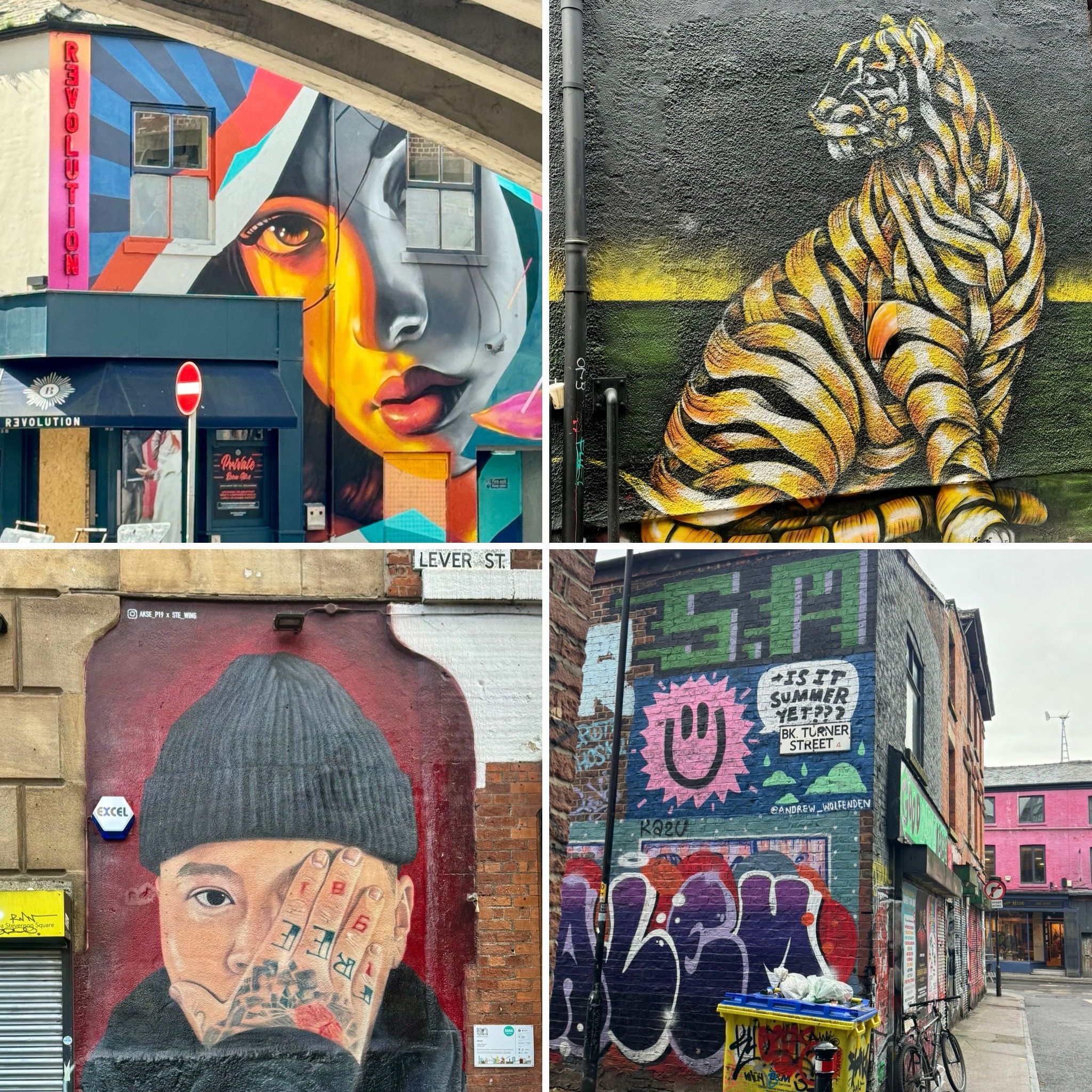An artful mix of old and new. Manchester still shows signs of its industrial past while embracing the future. Modern skyscrapers are layered on top of old brick architecture making it a fun city for wandering around.
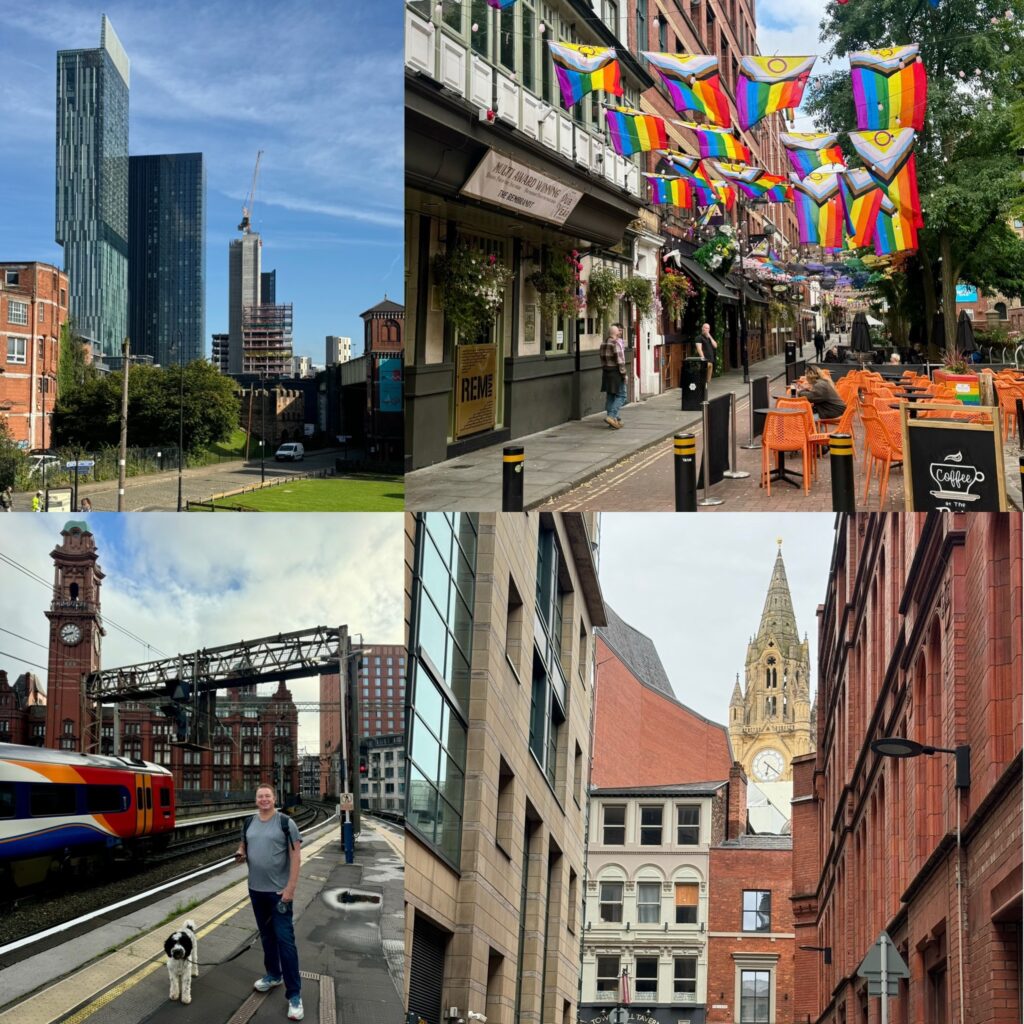
How did we decide to visit England’s second largest city? We were selected to care for the cutest cockapoo, Cookie, while his doggie daddies were out of town. We were thrilled to spend more time exploring England, in an area new to both of us.
We knew about Manchester United and the history of music and culture in Manchester. But we did not know that the bee is the symbol of Manchester. We spotted them all over the city! The worker bee represents the working people of industrial Manchester. The symbolism became stronger after a 2017 terrorist attack at an Ariana Grande concert, and now the bee is used to show that the city is stronger together.
Reflections From Our Visit
The more we explored, the more I appreciated all the sprawl. I had to also swallow some small annoyances like disjointed public transit and frequent rain showers (even in the summer).
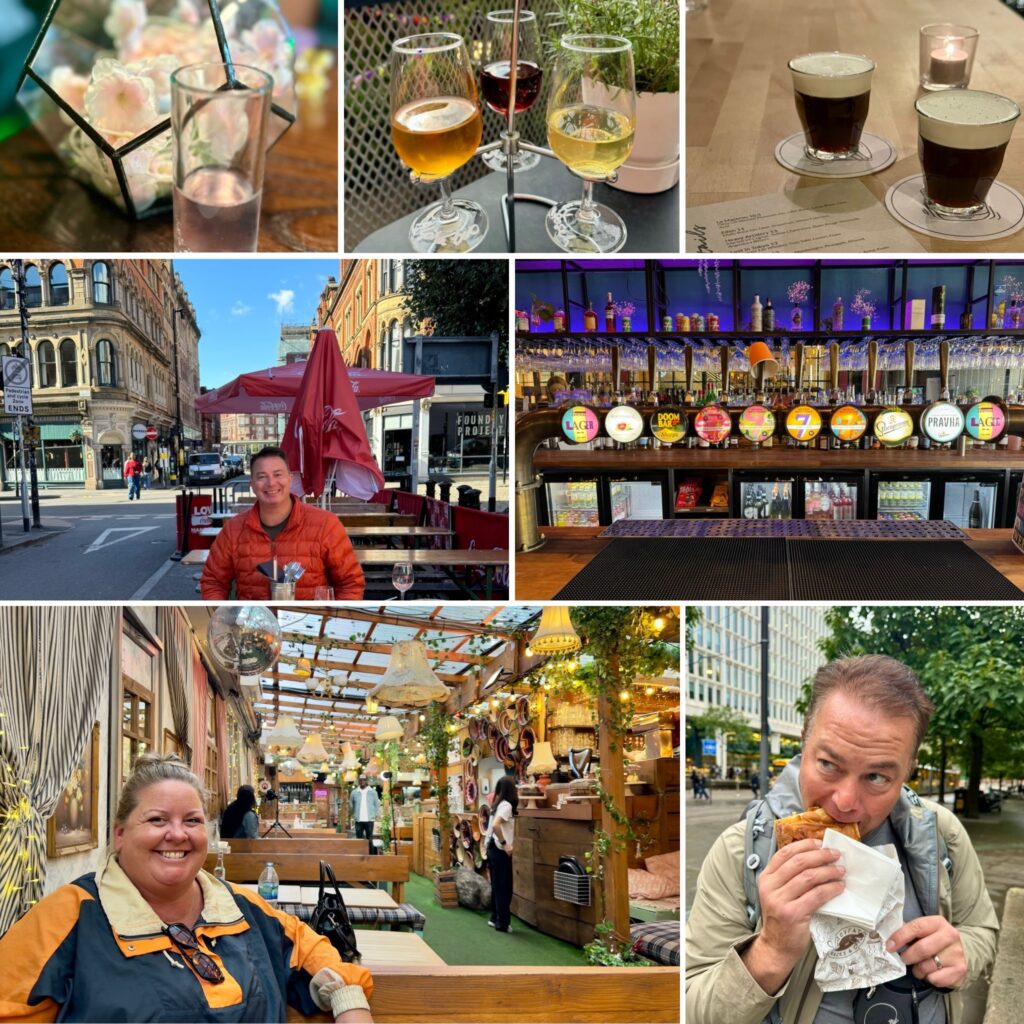
The way to my heart is through my stomach and the food scene in Manchester definitely delivers. Speakeasies, craft cocktail bars, pizza places, fine dining, and a large variety of ethnic cuisine. Any dish you can dream up, you would be sure to find somewhere in Manchester.
With all that eating, it was important to burn calories. So I played tennis. A lot of tennis.
Upon arriving, I joined a local online tennis group and immediately made friends. We were conveniently staying near Alexandra Park, a beautiful Victorian park which had four lighted tennis courts. I really felt like I integrated with the community through tennis. Unlike other cities, we actually made friends through the sport which has been largely unsuccessful in other countries. Corey thinks it has something to do with speaking a common language.
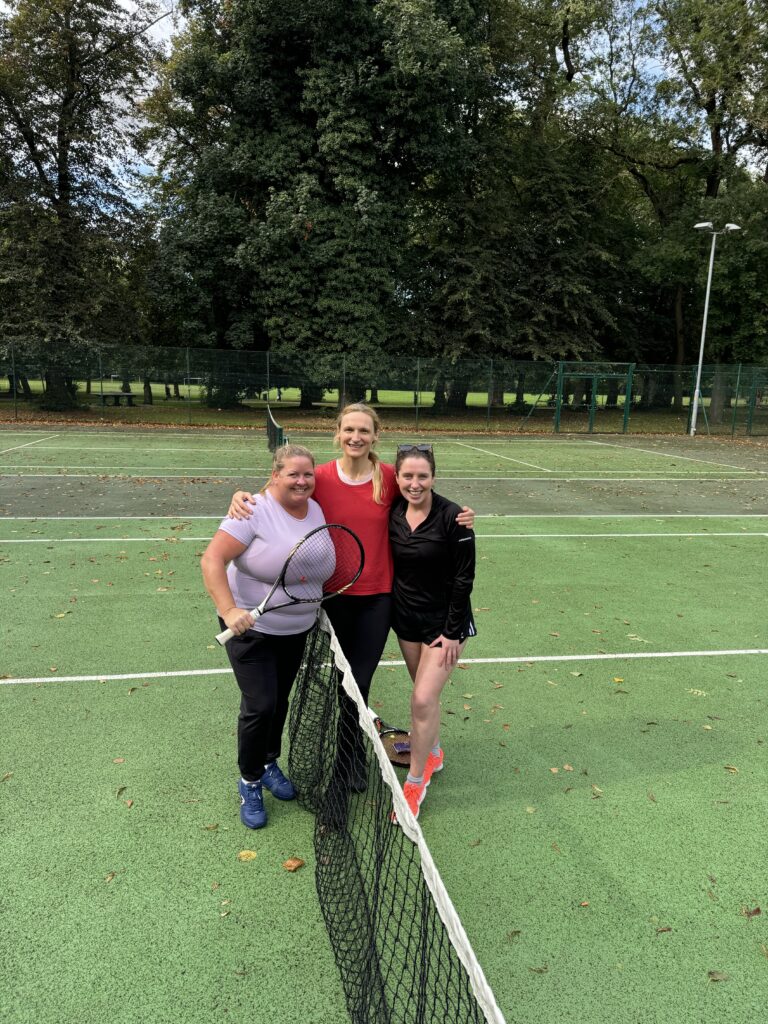
We also got to spend time with long time friends. Dr. Katy Finch, who I know from teaching English in Korea, lives in Manchester now. Over a decade ago we had many adventures together including a trip to the Great Wall of China and a weekender at Beoryung Mud Festival.
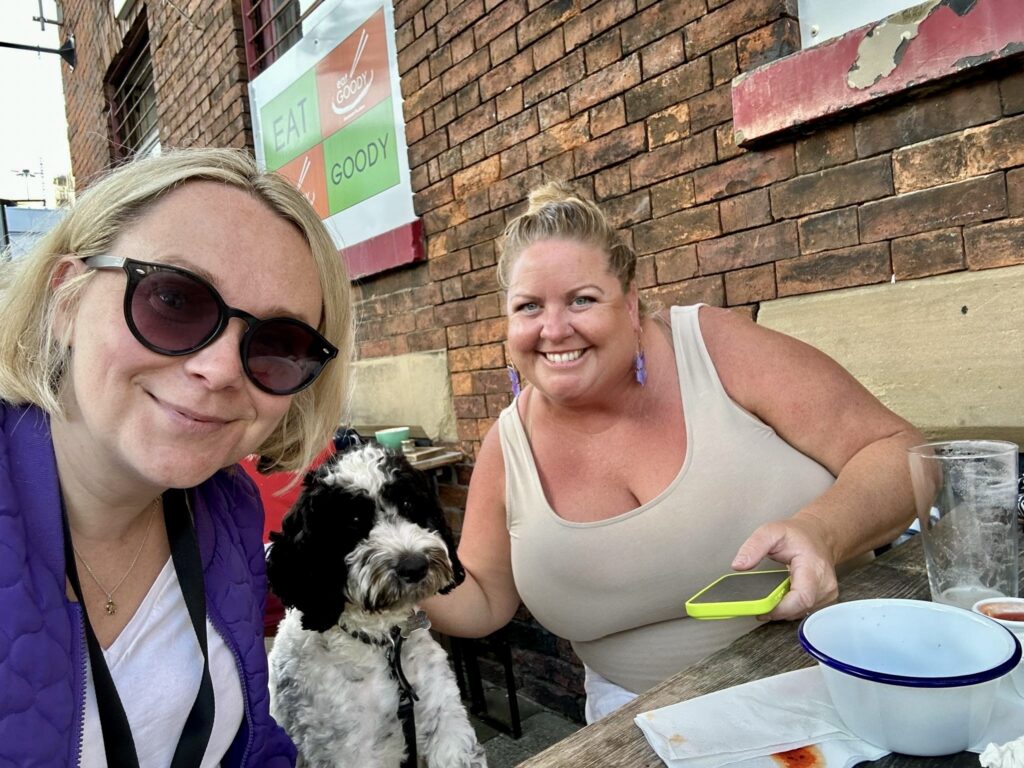
She helped us with sightseeing recommendations and we got to meet up on several different occasions including a hike and attending a live play, Murder on the Orient Express. The true highlight was meeting her adorable son, Finn.
We were staying south of the city center in a neighborhood called Fallowfield. During our five-week stay we enjoyed visiting the different neighborhoods and museums, most of which required navigating the bus. We also took a few day trips to visit other nearby cities.
Here are the highlights:
City Centre
The core of the city can be walked across in around 20 minutes and is brimming with cafes, bars, and restaurants. Most seem to offer lively patios and outstanding lunch specials. We had several visits downtown and we tried to experience different areas.
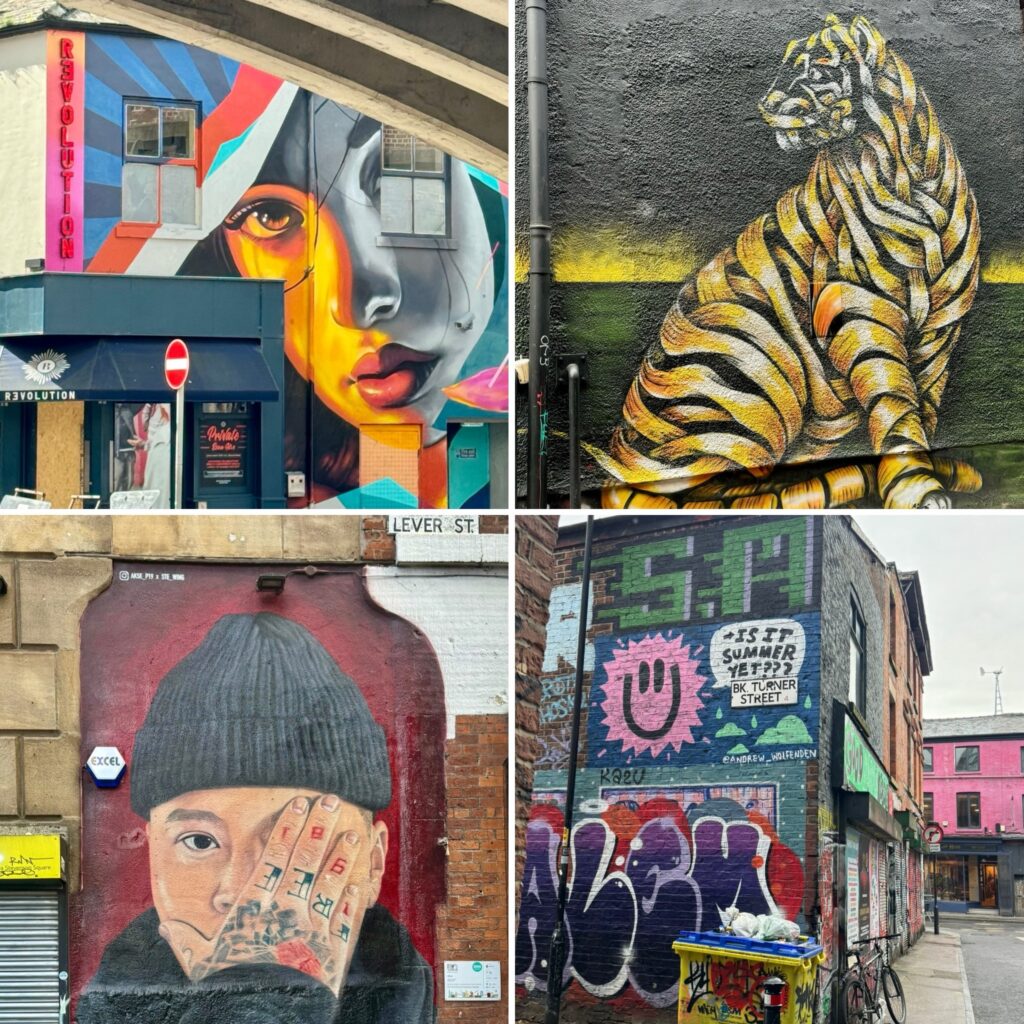
Most of “old” Manchester is represented by Victorian-era brick buildings, built during Manchester’s industrial boom time. Some of the fanciest-looking properties are old movie palaces, now converted to theaters or restaurants.
Manchester has very few buildings remaining from its medieval period. Some were demolished during the industrial boom, and others were destroyed in various wars. During reconstruction following an IRA bombing in 1996, some of the few remaining medieval buildings were moved and assembled into Shambles Square in 1999. The area reminded me of quaint European villages and the 400-year-old buildings were cute.
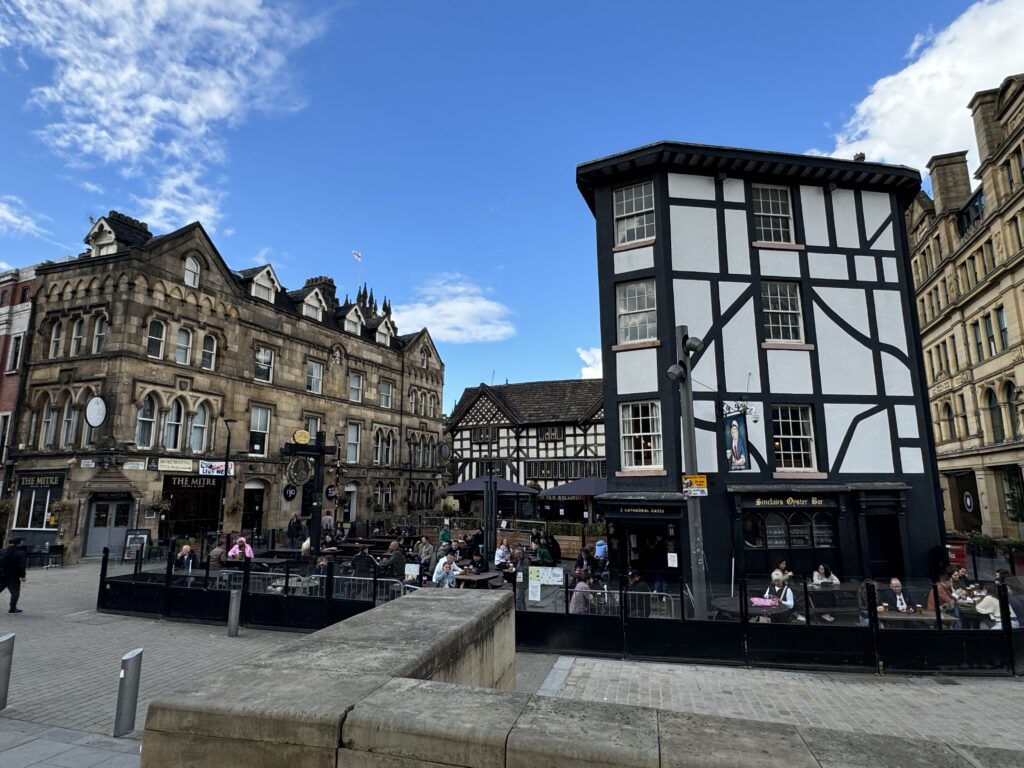
Towering just behind these establishments was Manchester Cathedral. It is an enormous jewel of a gothic church. Although it is made of stone, it has required many renovations and restorations over the years due to the use of soft stone for detail work, and also being affected by various bombings. We only got a small glimpse inside as most of it was closed off for an event.
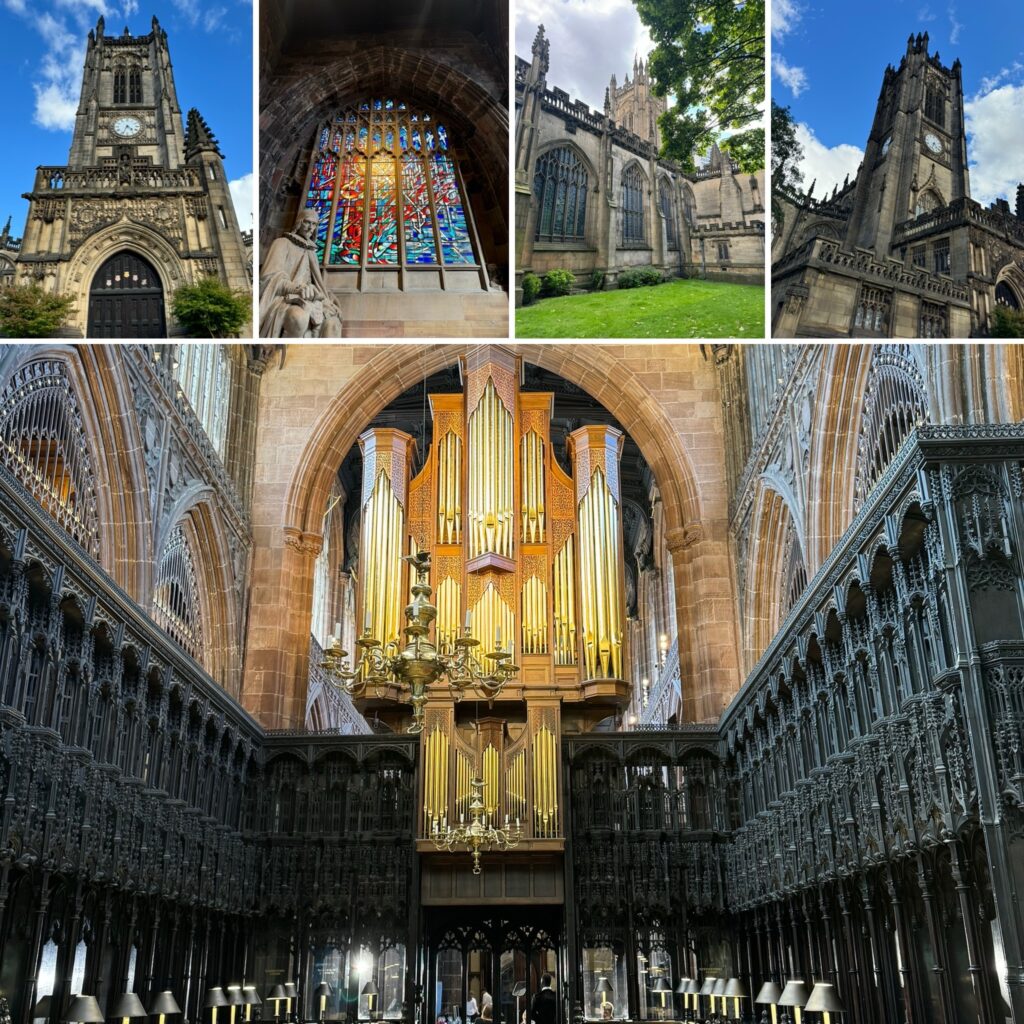
Old Roman Fort
One of the last days we were in Manchester, the weather gods gave us another deliciously sunny day. We took Cookie for a walk around the oldest part of the city. It is the site of a minor Roman fort, and the village that sprang up outside of the walls. It is currently a grassy park with some of the old stone foundations, and a reconstruction of some of the fort walls. It is worth a visit and a quick walkthrough to see how the existence of the rivers made Manchester a great spot for commerce, and worth defending. I like to see ancient edifices and better understand how folks lived long ago, but Cookie was not impressed and asked us to throw the tennis ball instead.
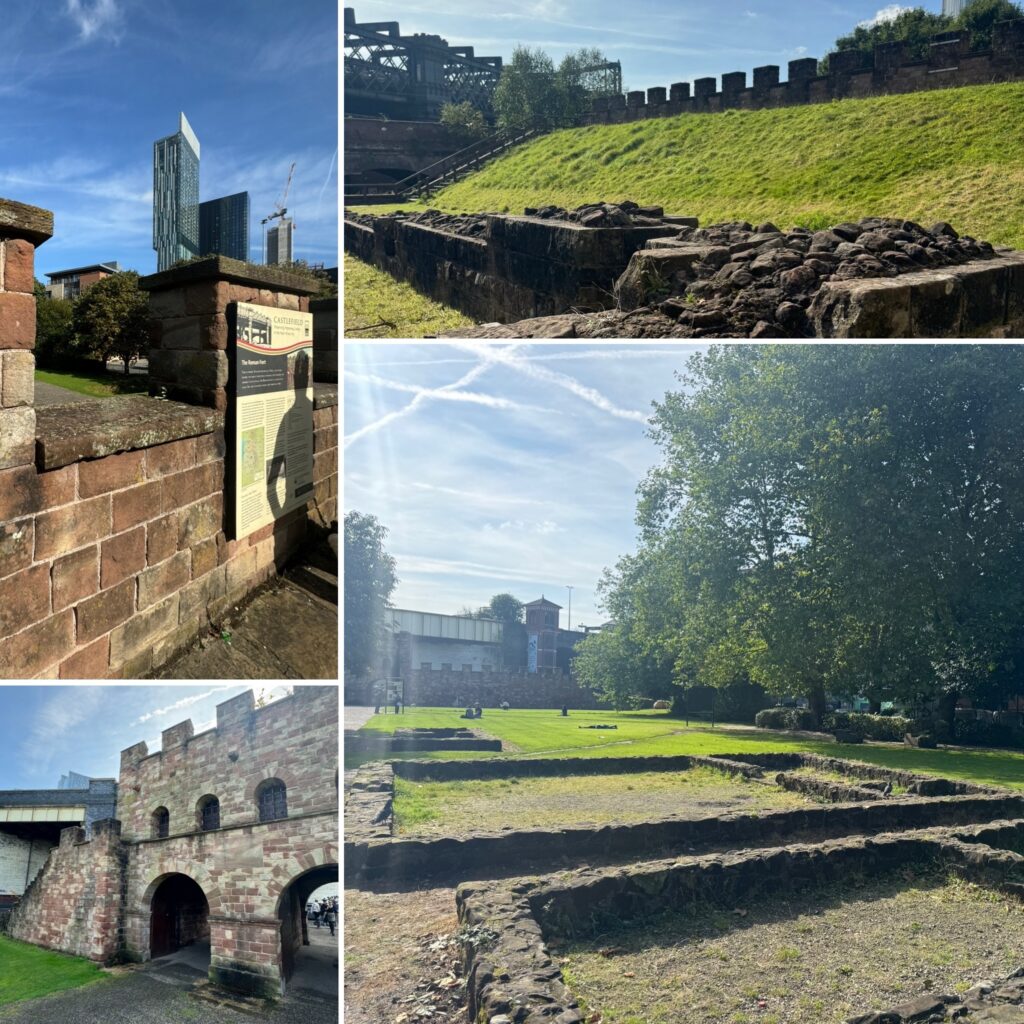
Right above the old Roman gardens is another old structure, Castlefield Viaduct. Formerly used for train traffic, this steel viaduct was kept in place and turned into a peaceful garden walk in the heights of the city. It reminded me of Seattle’s waterfront viaduct in the fleeting time when it was closed to cars but before it was demolished. I really wish Seattle would have kept and transformed its viaduct into something similar. Castlefield Viaduct was such a nice green space, floating above the industrial city and its canals and waterways.
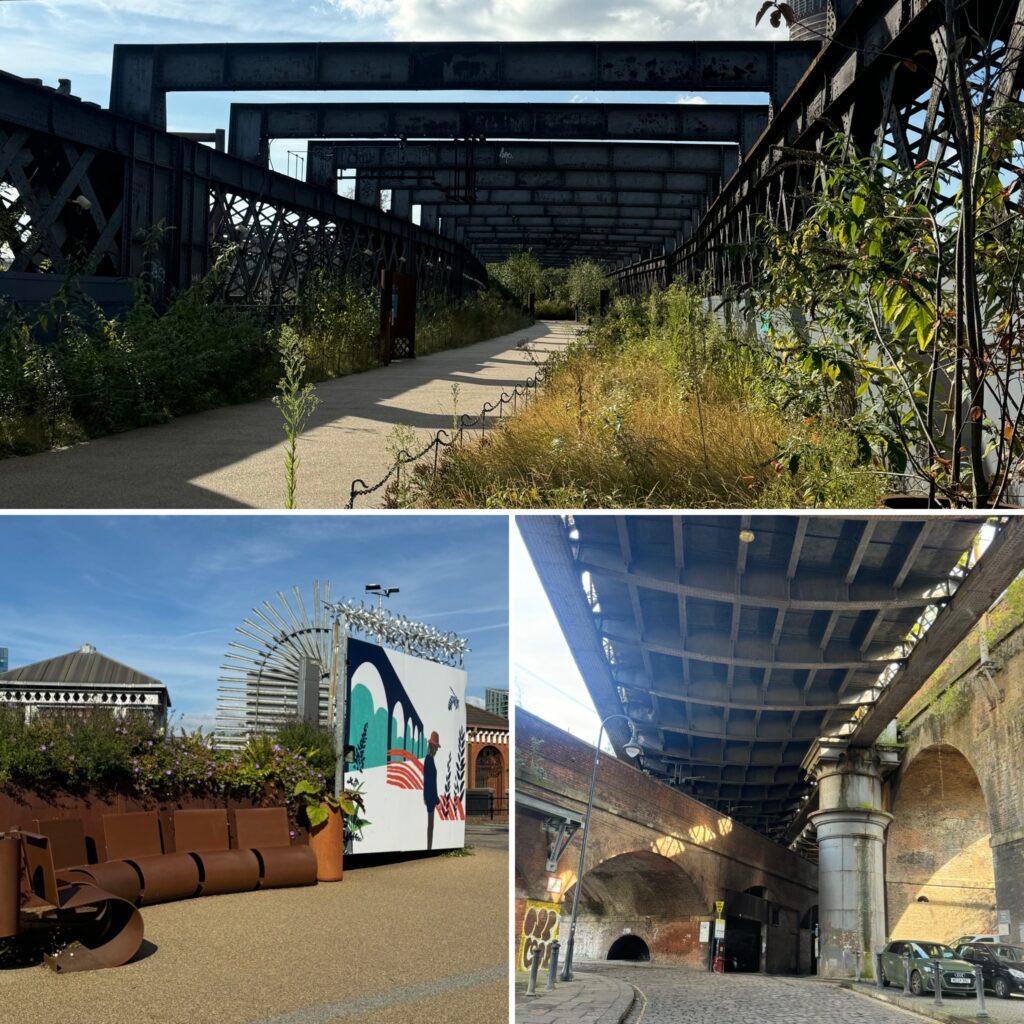
Salford Quays and MediaCity UK
We went on a long walk past Old Trafford, where Manchester United plays, then through the Salford Quays area, and on to MediaCity UK. This area is the redeveloped old harbor. It is a modern cross-section near downtown, with glassy buildings and fancy bridges spanning old canals. MediaCity has office buildings and television studios, and a couple of large plazas for enjoying lunch outside (while televisions were showing the Davis Cup).
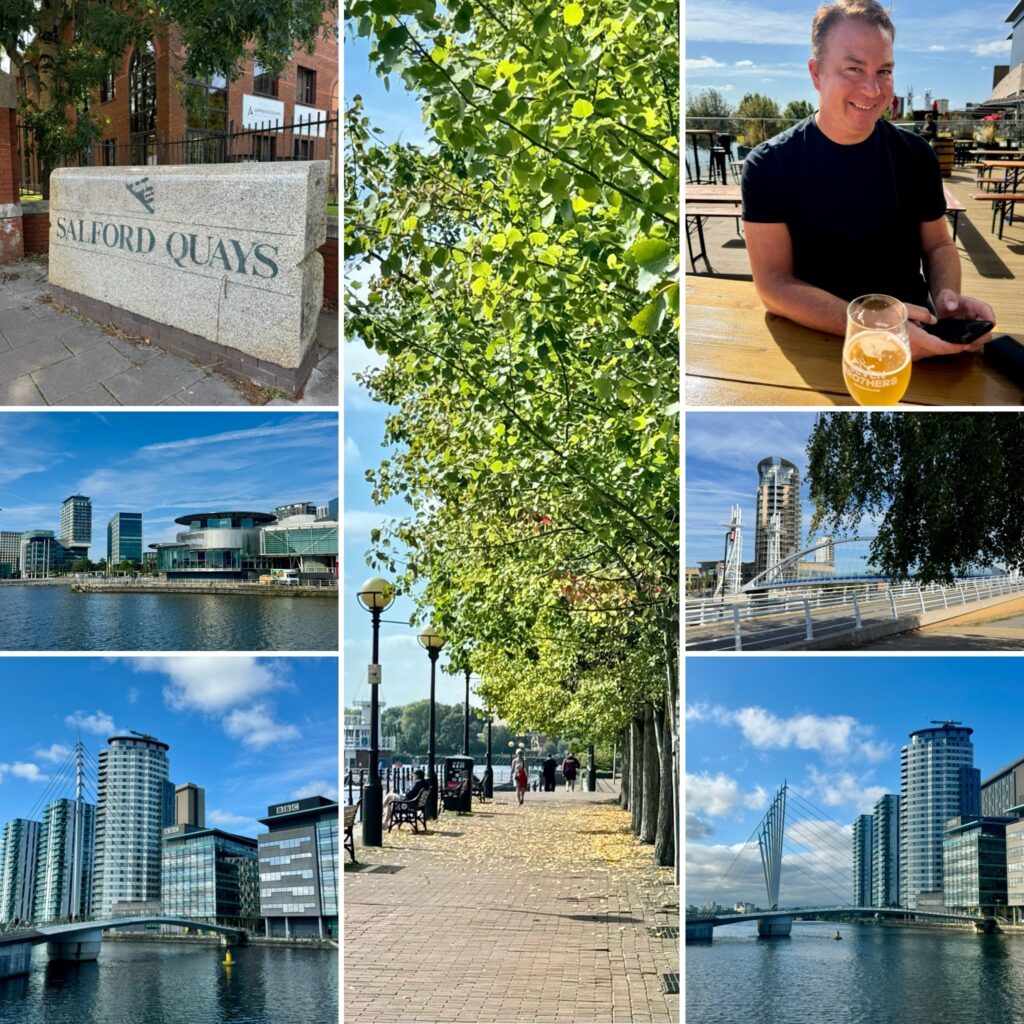
Walking along the canals and weaving around the buildings was a great way to spend a sunny afternoon.
We also paid a short visit to the Imperial War Museum – North, another free option. A branch of the larger museum in London, there is still a tremendous amount to see in this museum. After having seen the Southeast Asian perspectives on World War II, it was interesting to see a British perspective of the same events.
Ordsall Hall
Nearby Salford Quays lies a historic manor home that is now a museum. The two portions of the building date back to the 1400’s and 1600’s. It is open for self-guided tours, and we enjoyed being able to see the old timbers and construction, including plexiglass windows that show the roof and interior wall construction.
The museum details the history of the property, which was occupied by a family for more than 300 years, and eventually was used similarly to a community center. Now it contains Tudor-period furnishings, some of which are recovered originals to the property.
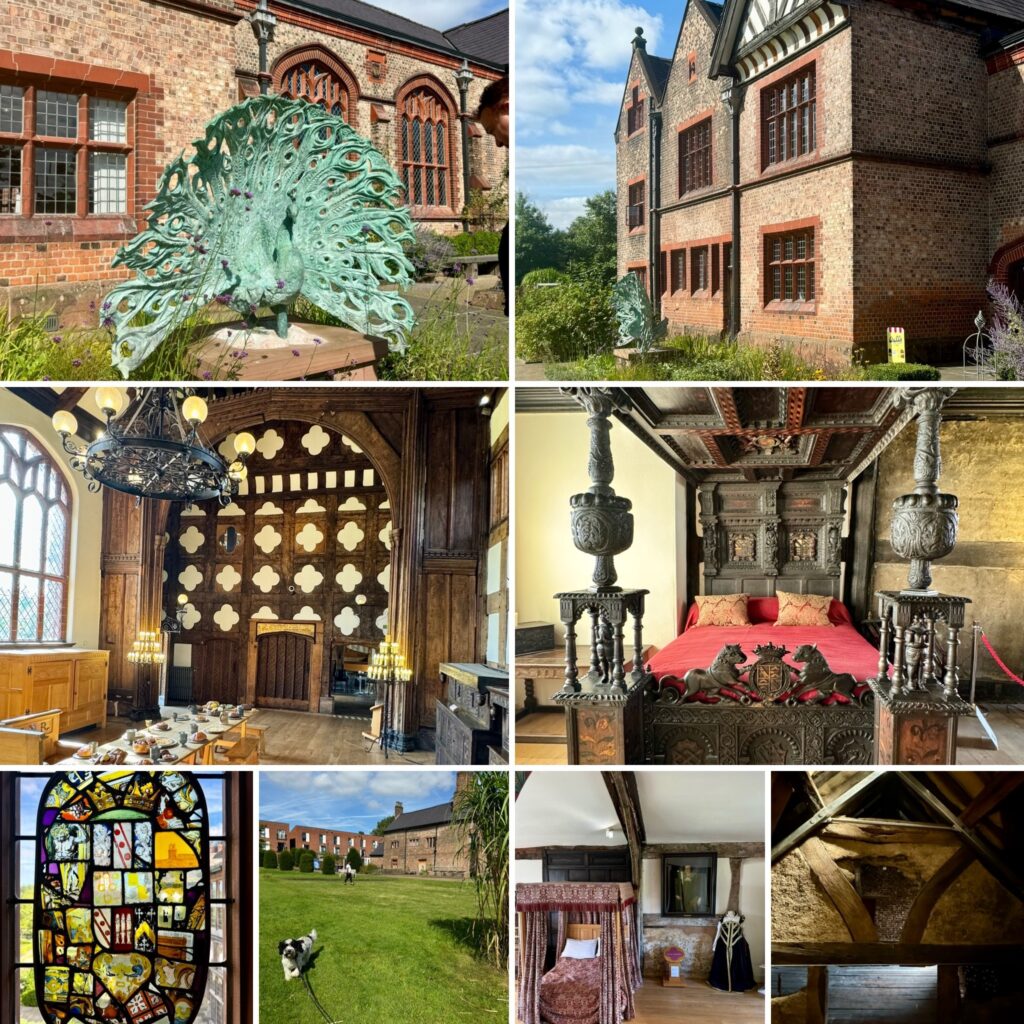
During our tour we learned a great deal about the many people who have lived in or passed through Ordsall Hall. I did not know it was haunted when we arrived, but it definitely had ghost vibes. While on tour I read about the haunting. In the past they have had cameras set up at night to capture any paranormal activity. More information can be found here.
Davis Cup Tennis
We lucked out to be able to spend a few afternoons watching professional tennis. The Davis Cup describes itself as the World Cup of Tennis, where top-tier tennis professionals play for their national teams in a tournament. We watched Argentina, Canada, Great Britain, and Finland play against each other in hopes of making it to the final round in Spain.
The LTA (Lawn Tennis Association) is the governing body of tennis in the United Kingdom. Because I had signed up for LTA tennis news, I received an offer for free tickets to the Davis Cup. This was a great program and we appreciated the opportunity to see world-class tennis competitors in action!
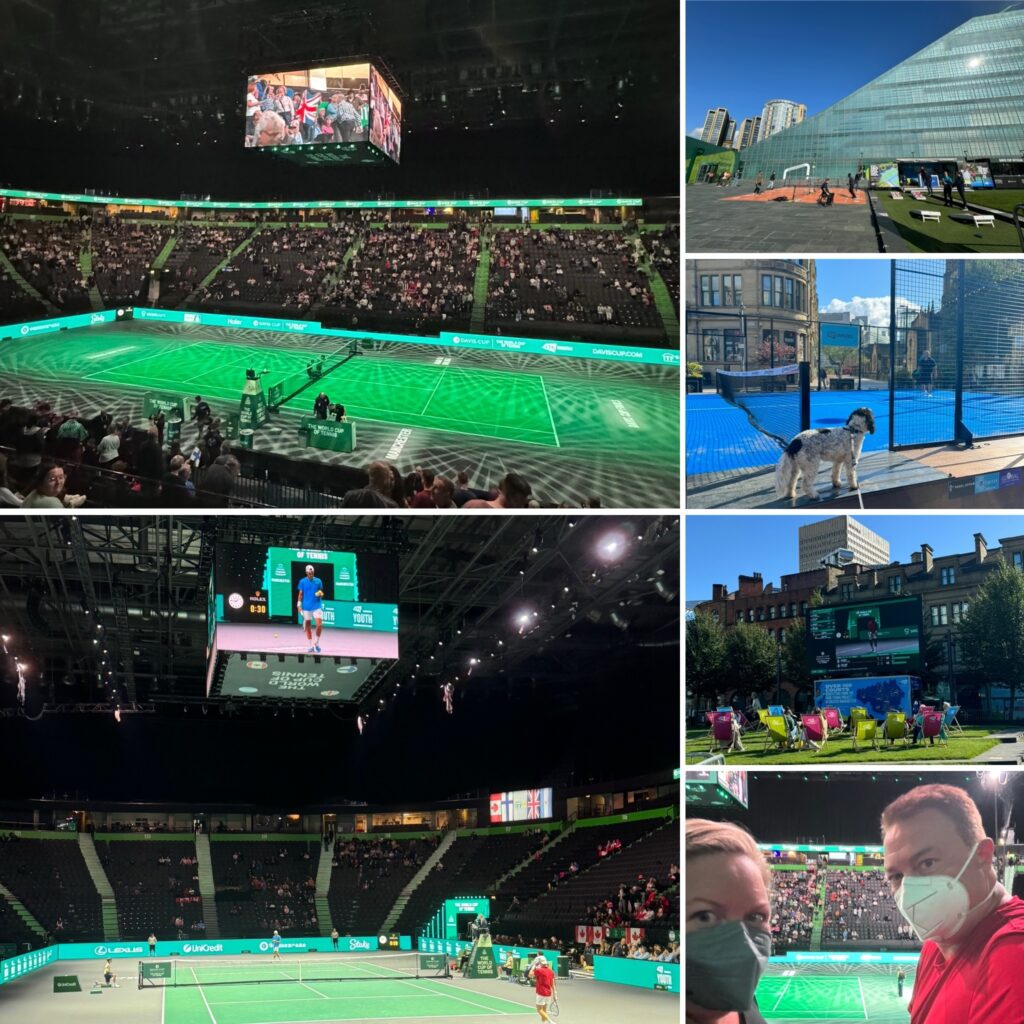
It was also an opportunity to take in the Manchester Arena (currently called AO Arena). Built adjacent to and above Victoria train station, the large arena is well-incorporated into the urban landscape. It has been the site of numerous boxing matches that Corey has watched on television.
Whitworth Gallery and Park
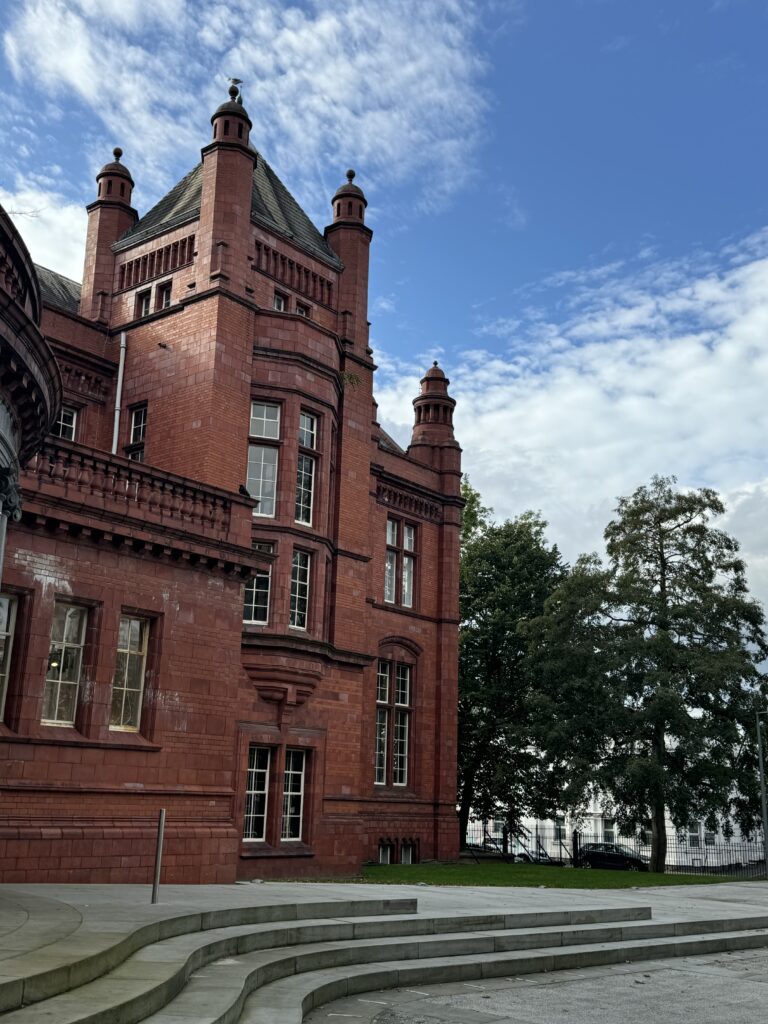
A short walk or bus ride from Fallowfield, we spent an afternoon enjoying the park, gardens and collections here. Like many other museums in Manchester (and in England), admission is free.
The rotating exhibits were limited, but I liked seeing the interesting collections of contemporary textile designs and the self-reflective exhibit on figure drawings.The Whitworth is also the northern start of Manchester’s “Curry Mile,” a long stretch of mostly-Indian restaurants and cafes.
Manchester Museum
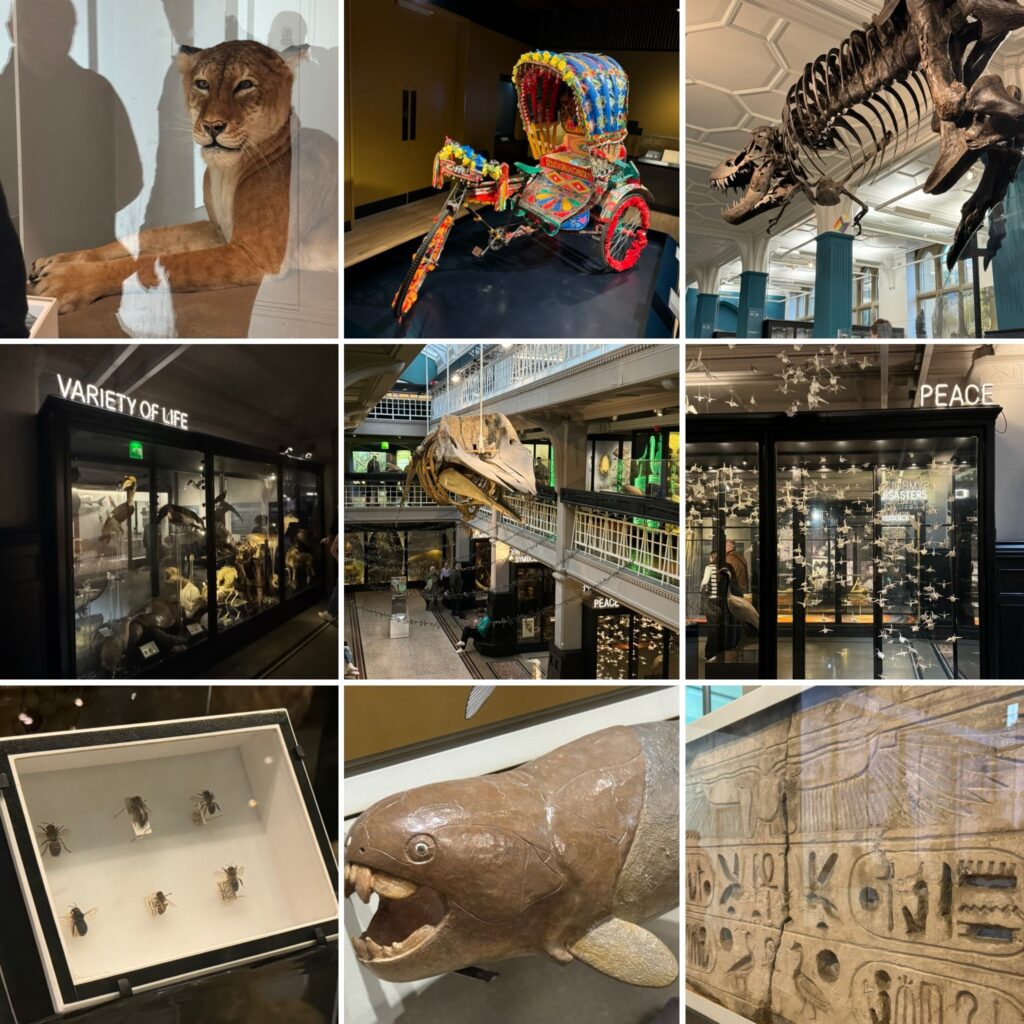
Though we have visited many natural history museums around the world, there is always something new to see and learn about. For Corey it was the terrifying salamander found in North America or the horrifying winged bottomfish. I liked seeing the tigon, a hybrid of a lion and tiger. Never knew this was a thing! (Top left in the photo collage above.)
I also really liked being able to see birds and dinosaurs native to England while in England.
Worsley
West of City Centre is the village of Worsley, which was connected to Manchester proper in 1761 via a long canal.
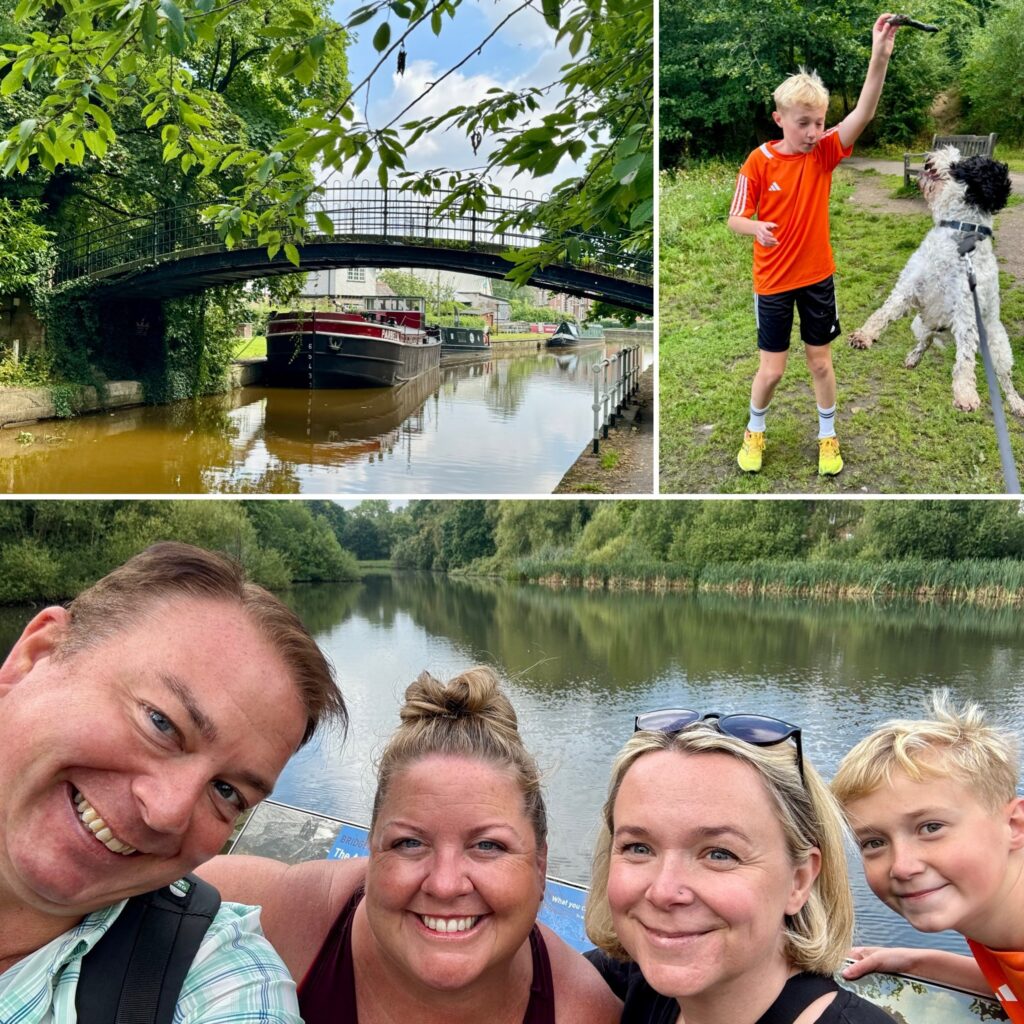
We would have never made it out to this neighborhood if not for Katy, who invited us out for a walk in the Worsley Woods with her son Finn. We walked on a long shaded path, then went for lunch at a nearby pub with a nice patio. The conversation was lovely as we discussed important topics like the merits of cheesecake and what exactly Whitby Scampi is (it is breaded langoustine, and yes, it does come from the Yorkshire town of Whitby).
The village reminded me of Seattle’s Wallingford neighborhood, with the quaint old buildings housing small cafes, restaurants, and salons. We continued onward and walked a good portion of the Bridgewater Canal, which is currently used mostly for pleasure craft. It still goes all the way into Manchester, but we used it to complete our loop hike and then took a bus back into town.
York (via train)
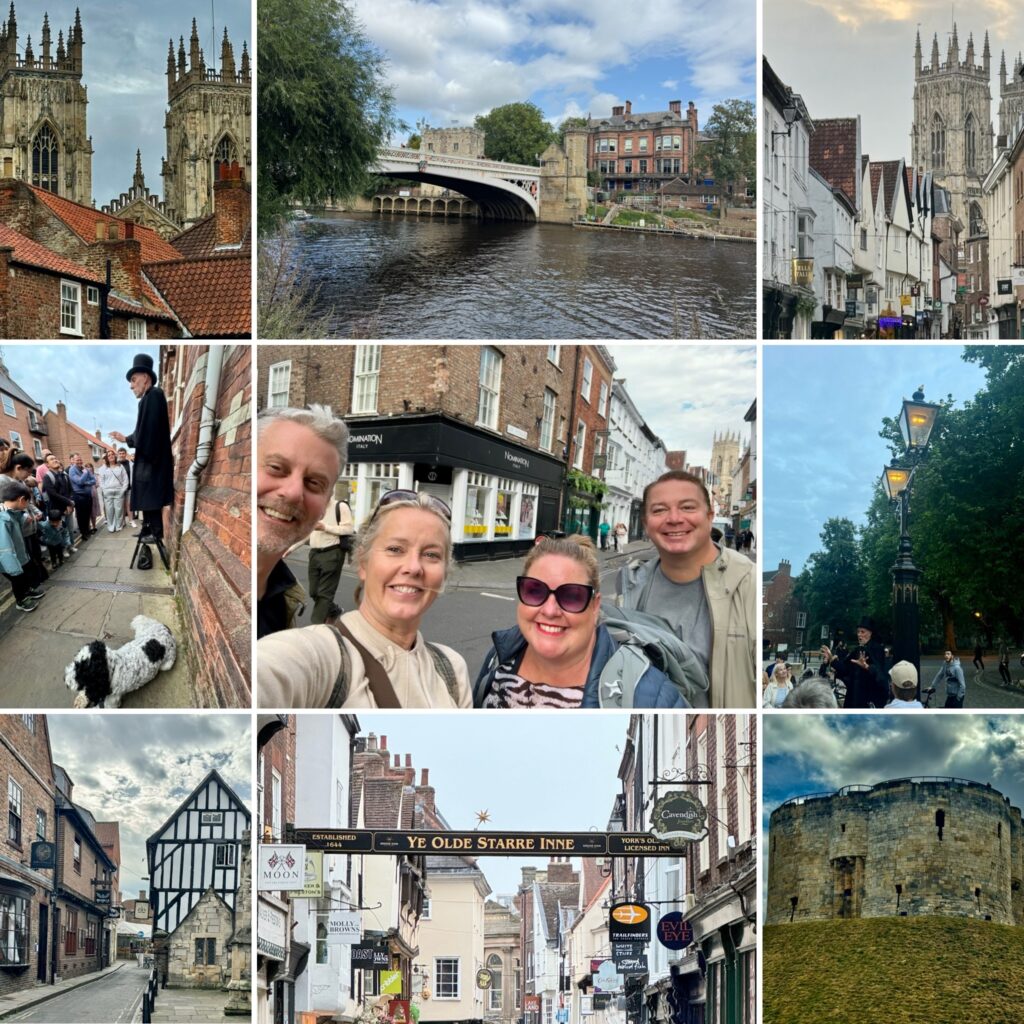
One of my favorite places in the world. York is a charming city with a long history, and it is only a couple hours east of Manchester by train. Two summers ago we visited there with my friend Dan, when we were staying with him in Scarborough. Well, we again visited with Dan! We celebrated his birthday and got to meet his lovely girlfriend, Jane.
We took Cookie with us for the overnight trip. It worked out great as we were able to take him on two tours. One was the nighttime ghost tour and the other was a ride around on the hop-on-hop-off bus. He traveled so well and he loved all the new smells!
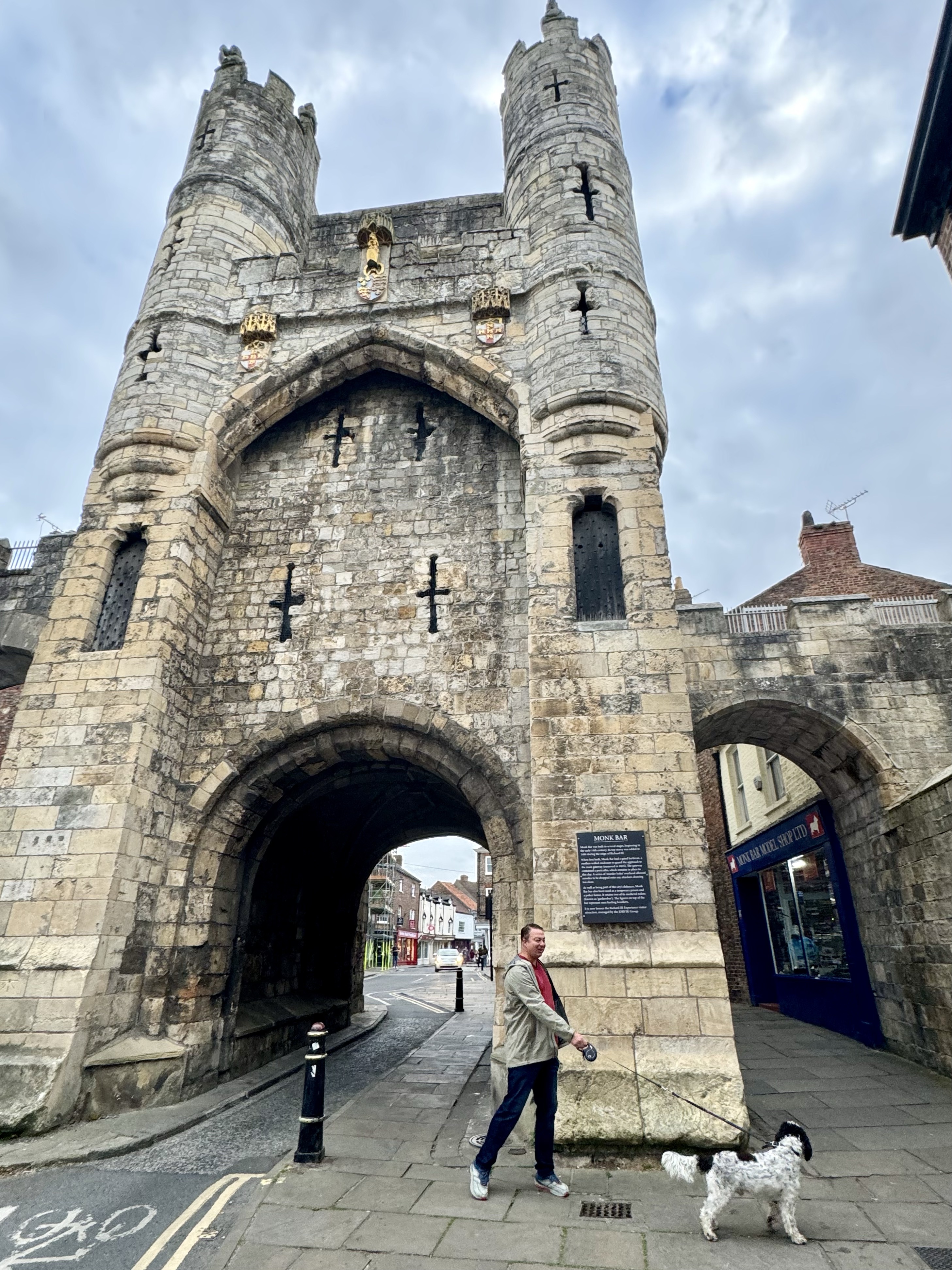
Liverpool (via train)
The other rail trip we took was to another one of England’s famous cities, and the birthplace of the Beatles, Liverpool.
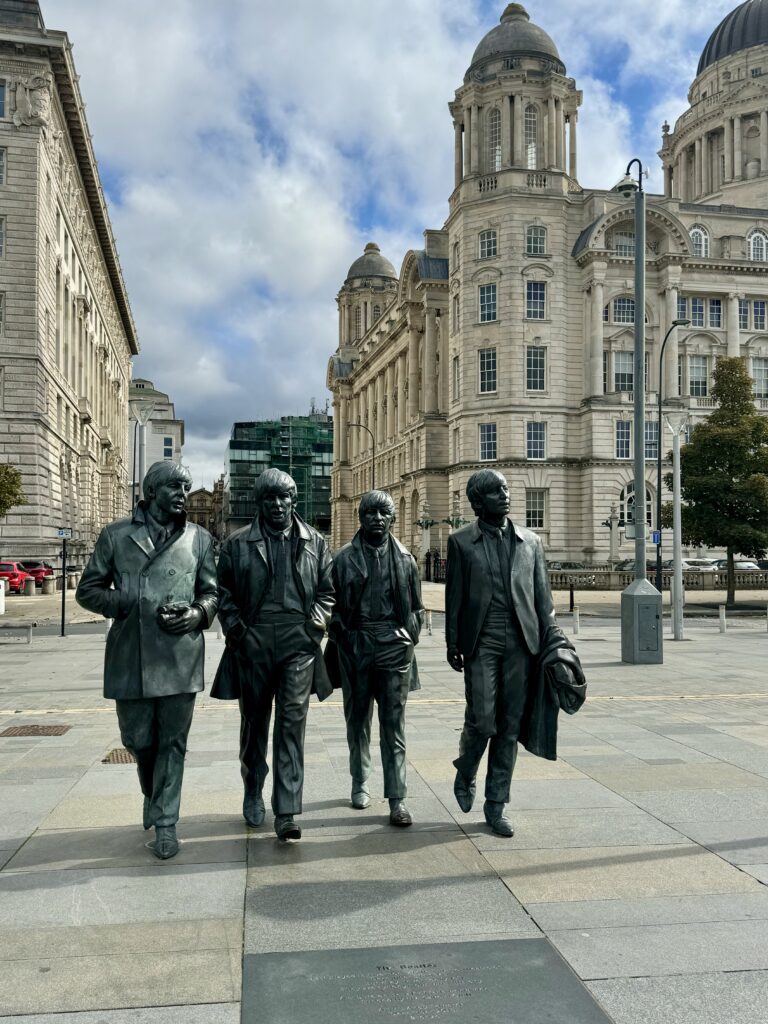
The day trip felt a bit like a cruise ship stop since we wanted to see everything we could in a short amount of time before heading back to Manchester. Also there was a cruise ship docked, and the closer we got to the port, the more American accents we heard.
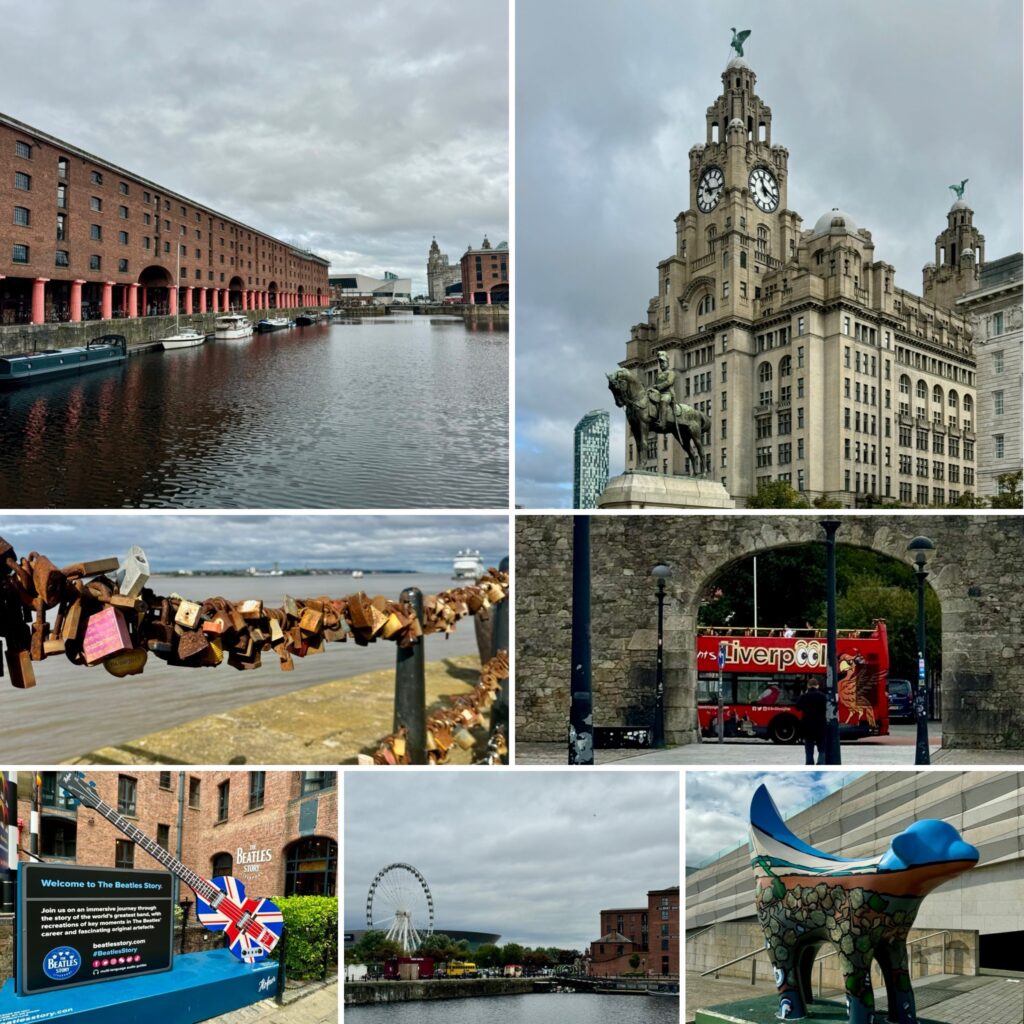
So we walked around a lot: about nine miles! We followed a couple of walking tours and saw the major buildings of the city, and spent plenty of time on the waterfront. We skipped touring any of the museums but we made a few stops.
Liverpool Central Library
The library complex has a main building that is modern and glassy, with a stately entrance and an observation deck. It connects to portions of the historic library, including the Picton Reading Room, a multi-story hall constructed in the style of Rome’s Pantheon. We were both impressed by this massive rotunda, where the eye in the roof looks down on the dark wood finishes and hundreds of books.
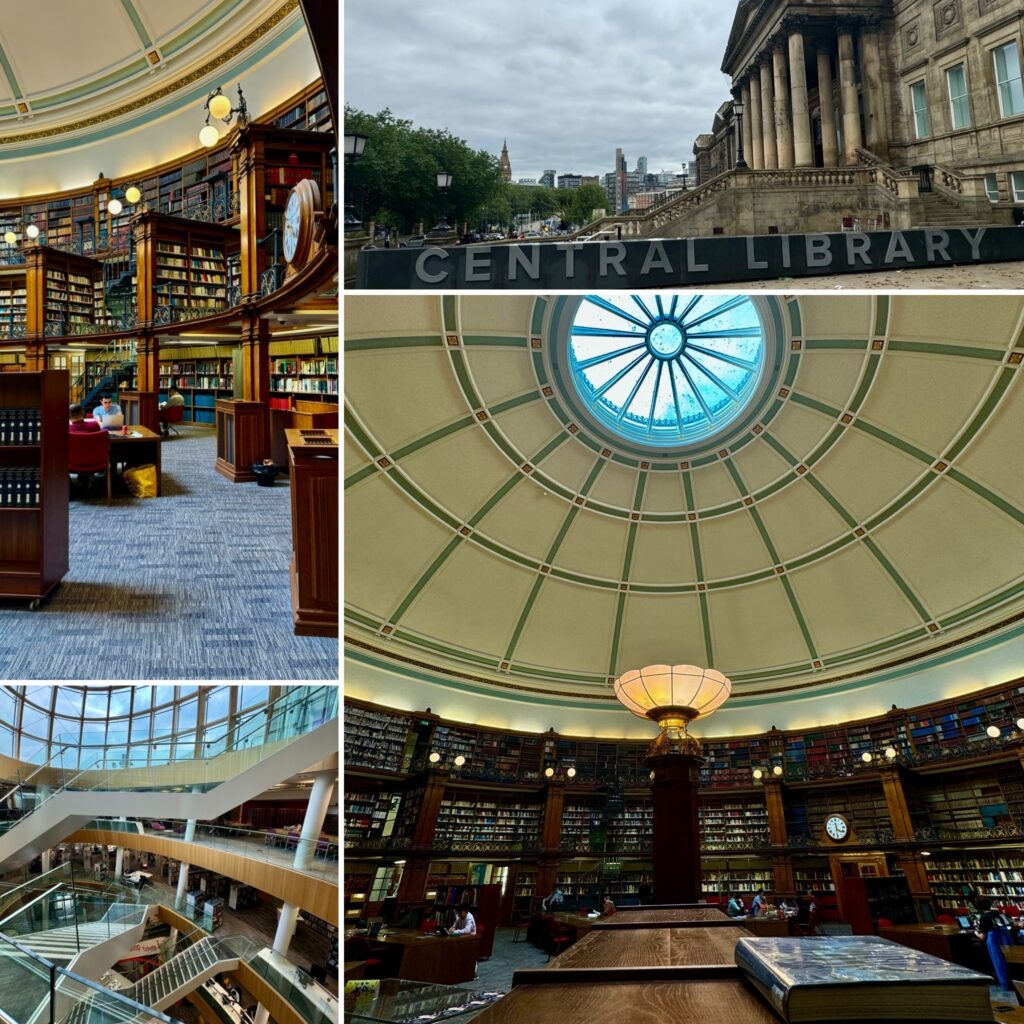
Liverpool Metropolitan Cathedral
There are two major cathedrals in Liverpool, and both are worth a visit. The Anglican Cathedral is enormous and traditional. We visited the Roman Catholic Metropolitan Cathedral, which was built in the 1960’s in a modern style.
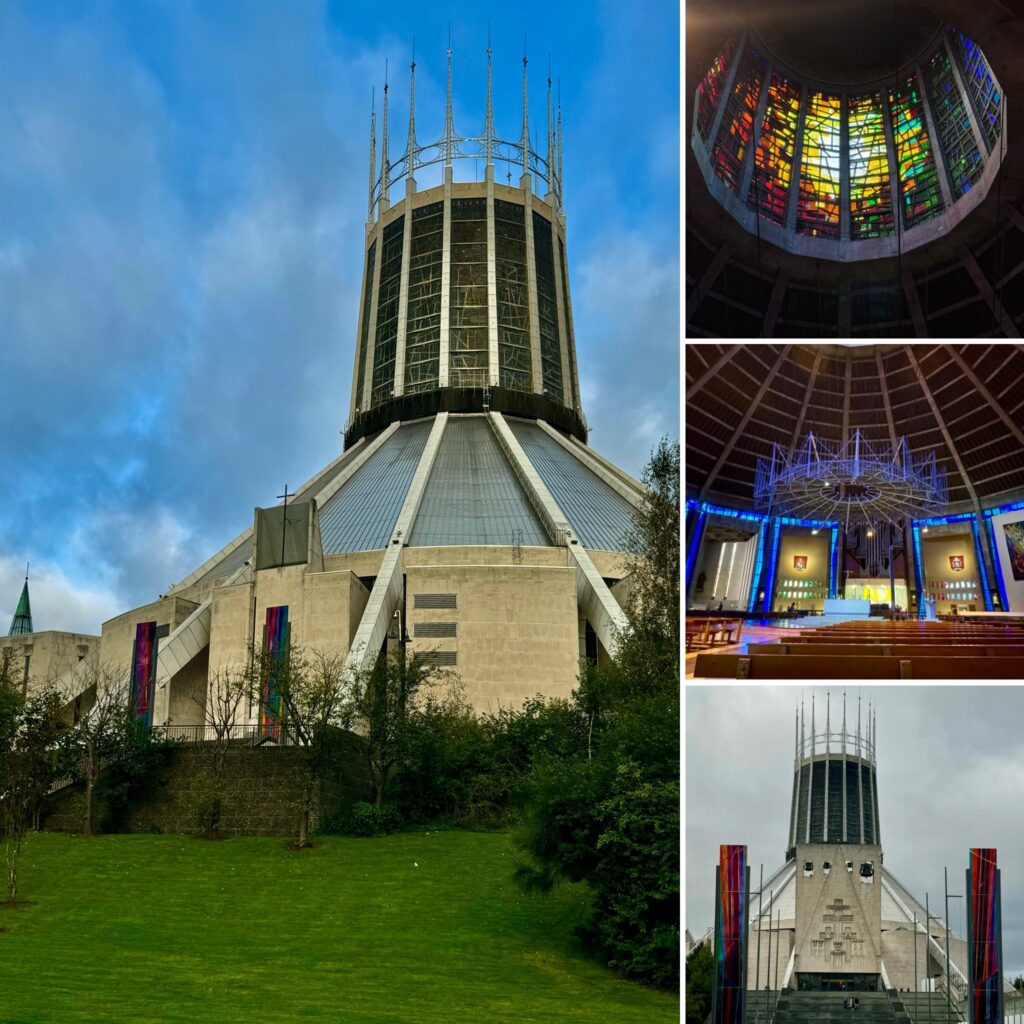
This was the most unique church I’ve ever visited. The outside resembles Space Mountain at Disneyland, and the lantern-like tower illuminates the church inside from all angles. This church is in the round, with a large main altar in the middle of the church, under the tower. Side chapels and altars are all around the circle, and there was a service taking place in one of those chapels when we were there.
The original plan was for a much larger, classic cathedral, but the only part that was constructed was the underground crypt. We have visited many large ancient churches that were built on top of smaller existing churches, and similarly, this crypt was designed to act as a foundation to support the larger construction. Touring it is a separate fee, which we did not have time for, but it is also used as a concert venue and an annual beer festival!
Overall
Manchester reminded us of the industrial cities of Midwest America: built for industry and reinvented for culture over the decades. Where trash-lined streets give way to alleys activated for nightlife. An inclusive and friendly city filled with grimy brick and shiny skyscrapers. Given the size of the city, there are plenty of things for visitors to see and do. Maybe one day we will return! We’d love to see Cookie again!
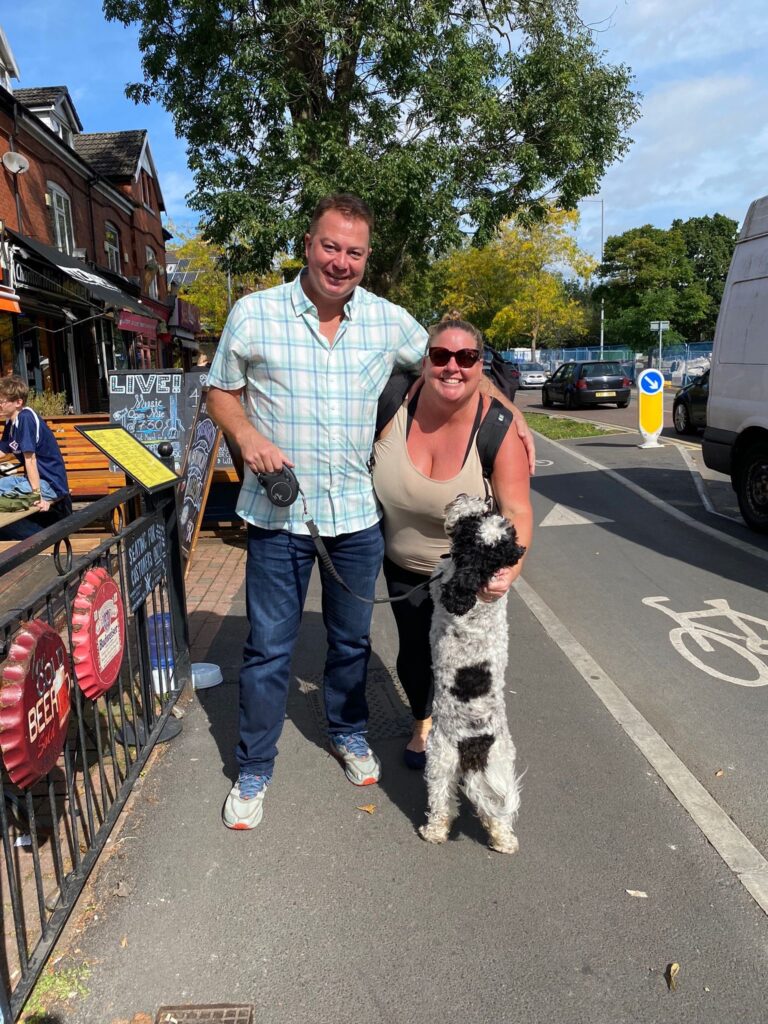
Next we head back to North America, where we become snowbirds: extending our summer by catsitting in Florida and heading south from there.
